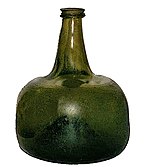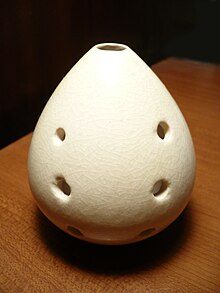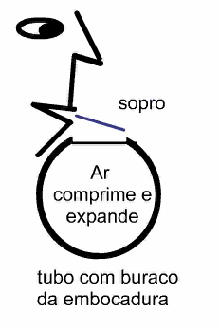
The flute is a member of a family of musical instruments in the woodwind group. Like all woodwinds, flutes are aerophones, producing sound with a vibrating column of air. Flutes produce sound when the player's air flows across an opening. In the Hornbostel–Sachs classification system, flutes are edge-blown aerophones. A musician who plays the flute is called a flautist or flutist.
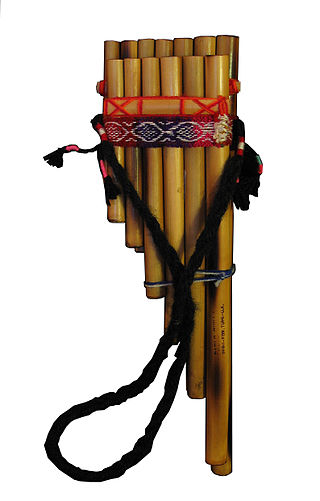
A pan flute is a musical instrument based on the principle of the closed tube, consisting of multiple pipes of gradually increasing length. Multiple varieties of pan flutes have been popular as folk instruments. The pipes are typically made from bamboo, giant cane, or local reeds. Other materials include wood, plastic, metal, and clay.

An overtone is any resonant frequency above the fundamental frequency of a sound. In other words, overtones are all pitches higher than the lowest pitch within an individual sound; the fundamental is the lowest pitch. While the fundamental is usually heard most prominently, overtones are actually present in any pitch except a true sine wave. The relative volume or amplitude of various overtone partials is one of the key identifying features of timbre, or the individual characteristic of a sound.

The tin whistle, also known as the penny whistle, is a simple six-holed woodwind instrument. It is a type of fipple flute, putting it in the same class as the recorder, Native American flute, and other woodwind instruments that meet such criteria. A tin whistle player is called a whistler. The tin whistle is closely associated with Irish traditional music and Celtic music. Other names for the instrument are the flageolet, English flageolet, Scottish penny whistle, tin flageolet, or Irish whistle.

The ocarina is a wind musical instrument; it is a type of vessel flute. Variations exist, but a typical ocarina is an enclosed space with four to twelve finger holes and a mouthpiece that projects from the body. It is traditionally made from clay or ceramic, but other materials are also used, such as plastic, wood, glass, metal, or bone.
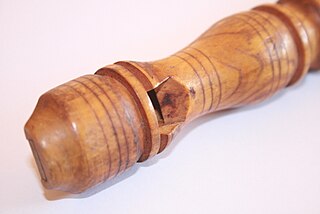
The term fipple specifies a variety of end-blown flute that includes the flageolet, recorder, and tin whistle. The Hornbostel–Sachs system for classifying musical instruments places this group under the heading "Flutes with duct or duct flutes." The label "fipple flute" is frequently applied to members of the subgroup but there is no general agreement about the structural detail of the sound-producing mechanism that constitutes the fipple, itself.

A resonator is a device or system that exhibits resonance or resonant behavior. That is, it naturally oscillates with greater amplitude at some frequencies, called resonant frequencies, than at other frequencies. The oscillations in a resonator can be either electromagnetic or mechanical. Resonators are used to either generate waves of specific frequencies or to select specific frequencies from a signal. Musical instruments use acoustic resonators that produce sound waves of specific tones. Another example is quartz crystals used in electronic devices such as radio transmitters and quartz watches to produce oscillations of very precise frequency.
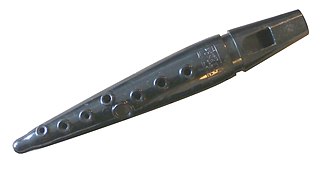
The stub-ended Swanson tonette is a small, end-blown vessel flute made of plastic, which was once popular in American elementary music education. Though the tonette has been superseded by the recorder in many areas, plastic Tonettes are still in use in elementary schools around the nation due to their price, durability, and simplicity. The range of the tonette is from C4 to D5. A skilled player can produce notes above the principal register by overblowing and half-covering holes. Similar instruments are the song flute, flutophone, and precorder.

A steam whistle is a device used to produce sound in the form of a whistle using live steam, which creates, projects, and amplifies its sound by acting as a vibrating system.
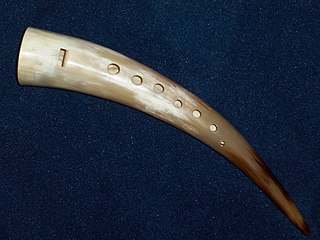
The gemshorn is an instrument of the ocarina family that was historically made from the horn of a chamois, goat, or other suitable animal. The gemshorn receives its name from the German language, in which Gemshorn means a "chamois horn". According to Etymologist Francesco Perono Cacciafoco, the form could have prehistoric origins and come from Proto-Germanic *gămĭtă-χŭrnă-n < Indo-European *gʱŏm-ĭdó-ḱrhₐ-nŏ-m > Gämshorn, indicating a "'specific' wind instrument, crafted by using the horns of ungulated animals and different from a hunting horn or a signaling horn".

Helmholtz resonance, also known as wind throb, refers to the phenomenon of air resonance in a cavity, an effect named after the German physicist Hermann von Helmholtz. This type of resonance occurs when air is forced in and out of a cavity, causing the air inside to vibrate at a specific natural frequency. The principle is widely observable in everyday life, notably when blowing across the top of a bottle, resulting in a resonant tone.
The Native American flute is a musical instrument and flute that is held in front of the player, has open finger holes, and has two chambers: one for collecting the breath of the player and a second chamber which creates sound. The player breathes into one end of the flute without the need for an embouchure. A block on the outside of the instrument directs the player's breath from the first chamber—called the slow air chamber—into the second chamber—called the sound chamber. The design of a sound hole at the proximal end of the sound chamber causes air from the player's breath to vibrate. This vibration causes a steady resonance of air pressure in the sound chamber that creates sound.

The fujara is a large wind instrument of the tabor pipe class. It originated in central Slovakia as a sophisticated folk shepherd's overtone fipple flute of unique design in the contrabass range.

Acoustic resonance is a phenomenon in which an acoustic system amplifies sound waves whose frequency matches one of its own natural frequencies of vibration.

Bass traps are acoustic energy absorbers which are designed to damp low-frequency sound energy with the goal of attaining a flatter low-frequency (LF) room response by reducing LF resonances in rooms. They are commonly used in recording studios, mastering rooms, home theatres and other rooms built to provide a critical listening environment. Like all acoustically absorptive devices, they function by turning sound energy into heat through friction.
The Turkish ney is an end-blown flute made of reed, an Ottoman variation on the ancient ney. Together with the Turkish tanbur lute and Turkish kemençe fiddle are considered the most typical instruments of Classical Turkish music. The ney also plays a primary role in the music of the Mevlevi Sufi rites (semâ).

A nose whistle is a wind instrument played with the nose and mouth cavity. Often made of wood, they are also constructed with plastic, clay, or sheet metal.

A wind instrument is a musical instrument that contains some type of resonator in which a column of air is set into vibration by the player blowing into a mouthpiece set at or near the end of the resonator. The pitch of the vibration is determined by the length of the tube and by manual modifications of the effective length of the vibrating column of air. In the case of some wind instruments, sound is produced by blowing through a reed; others require buzzing into a metal mouthpiece, while yet others require the player to blow into a hole at an edge, which splits the air column and creates the sound.

A shepherd's whistle is a specialized, modulatable, variable-pitch whistle used to train and transmit commands to working dogs and other animals. Unlike other whistles, they are placed inside the mouth. The pitch is controlled by the placement of the tongue; physically, shepherd's whistles are vessel flutes with the tongue forming one side of the resonating chamber, and controlling its size. Like tin whistles, while simple, they can be used as musical instruments in their own right.

The hand flute, or handflute, is a musical instrument made out of the player's hands. It is also called a hand ocarina or hand whistle. To produce sound, the player creates a chamber of air with their hands, into which they blow air via an opening at the thumbs. There are two common techniques involving the shape of the hand chamber: the "cupped hand" technique and the "interlock" technique.

